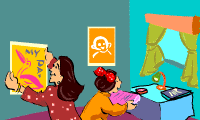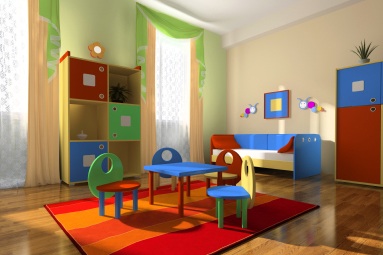Children seem to grow at a fast pace and there comes a time when she seems ready for her own room. Your child will enjoy this ‘space’ and you too, will appreciate having some quiet time during the day! However, before you go ahead with this plan, plan it out.
Room at a child’s eye level
The way you plan the room must be congenial to a child’s scale, literally. That’s the only way she will feel it to be her own space.
While you are thinking from a child’s perspective, it might help to get some inputs from your child as well. She will feel involved as well. Also, planning what should be kept where will give her a sense of colour and creative dimensions.
Pick a theme
While selecting a theme for the room, remember to think about your child’s likes and dislikes. For example, if she loves being outside, then a garden theme may work. If she loves animals, perhaps a little jungle corner will work. Go through your child’s books and toys for all the creative inputs that you can do with.
Once you pick a theme, you can start making a list of things to buy that will complement each other. And then the rest of the room will quickly fall into place. You can carry the theme into the bedding and a border or you can go wild and paint the furniture to match.
Furniture
Make a list of all the things that your child likes to do: dressing- up, colouring, reading and so on. Make this list before you decide what furniture you want in the room. Then design ‘play stations’ around the room to accommodate these activities.
For example, you could hang the mirror on the wall at your child’s eye level, which will make a perfect dressing corner. Once you figure out the activities, then your furniture needs are easy.
My own experience has been quite revealing. It was becoming quite a task to get my son to clean up his room. So I had a glass-fronted chest made for his cars and other toys. Now, whenever he picks a toy from inside, he places it back after he is through with it. This has given him a sense of responsibility about his own things – a sense of cleanliness has followed from it.
It makes sense to have furniture that will not outgrow the child: the dolls and blocks decorating a plain book shelf can be put away and trophies and computer games can be added.
Plan for lots of storage space. Use old shoeboxes to sort out toys that tend to scatter around, or opt for stackable plastic boxes. Clear ones will help the child see what is inside them and prevent a lot of mess. Wide, shallow drawers will help you store art paper and art supplies. Make sure to have lots of hooks on which your child can hang her knapsack, jacket and raquet.

Planning For A New Room [Illustration by Shinod AP]
Think about the wall space too. You might want to plan hanging pictures or artwork among other things. A large (4’x6′) bulletin board works wonderfully as a place to hang prized artwork, pictures, photographs of a memorable trip, greeting cards and anything that your child might want to highlight.
Here are some handy tips, while planning the room:
- Most importantly, plan the room so that it will be done. Don’t complicate your ideas so that the room is constantly ‘almost’ done. If you cannot afford to complete the room at one time then break-up the room into projects.
- Plan a realistic room based upon your time, money and abilities.
- Remember to include your child’s suggestions.
- If possible, include your child in some planning activities as well, like deciding colours, shopping etc.
- For more ideas you could leaf through the many catalogues on usage and design that come in handy these days.Finally, when the room is ready, don’t forget to photograph/videotape your child as she enjoys her room for the first time.










